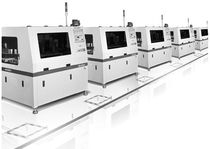Implementing Press-fit Pin Technology into Existing Automation Processes
Even before lead-free processing became a concern, secondary soldering operations have presented difficult challenges. Achieving both high productivity and volume assembly throughput with solder tail terminals was not always possible. This is especially important in the automotive industry, where large molded connectors are frequently used for both power and control signals. Manufacturers need to combine efficient automated assembly of connectors while minimizing issues associated with soldering processes. To meet this goal, press-fit technology allows high-speed machine insertion of single or multiple compliant pins and terminals that require no subsequent soldering steps and provide a high level of retention strength.

Press-fit technology, also known as an interference fit or friction fit, has been proven and is widely used in the automotive and telecommunications industry. In many cases, it has eliminated soldering for pin-intensive interconnect systems. It is continually evolving to meet new manufacturing challenges and address a broader range of product requirements.
The key challenge involves achieving the proper balance between the insertion force required and the amount of retention (e.g. the withdrawal force required to extract the pin). The retention force has to be as close as possible to the insertion force to get maximum robustness of the connection. Too much deformation of the press-fit section can result in reduced normal force between the compliant pin and the barrel of the hole. It degrades the retention force and performance over the product’s life.
Gas Tight Fit with High Retention
Autosplice offers press-fit solutions that provide our customers with solderless, internally powerful, gas-tight connections. Our compliant press-fit pins have been thoroughly tested to all industry standards. The friction fit of the press-fit pin provides a gas tight connection with sufficient retention force. It maintains a high normal force on the plated through hole (PTH) of the printed circuit board, and eliminates the need for soldering. After the insertion of a compliant pin the interconnection is completed in the most efficient way.

As the press-fit pin’s eye-of-the-needle section absorbs the deformation of the friction fit and doesn’t deform the plated through hole. That is why it is possible to remove the press-fit pin at a later point without damage to the PCB or the need for extensive rework. It is possible to remove damaged press-fit pins with the help of a simple hand tool. It allows to insert a new pin in the old plated through hole.
The continuing trend toward fine-pitch surface mount technology (SMT) designs is also made easier by using press-fit pin technology. As the spacing between connections gets smaller, the soldering challenges increase significantly. The overall process must be more tightly controlled. Deposition of solder paste must be held within very tight tolerances to avoid bridging or solder-balling between pads. This need to minimize solder volumes conflicts with SMT and pin-in-paste connector requirements. They often need larger solder fillets to assure the robustness for external physical connecting forces. Compliant press-fit pins allow the manufacturer to eliminate the hassles, specialized equipment and extra costs associated with soldering connectors on small fine-pitch SMT boards.
Designed and Packaged to Facilitate Automation Process
All Autosplice press-fit pins are supplied in continuously reeled formats as either individual or multiple position connector components for insertion by high-speed pin insertion machines. This enables the press-fit technology to be efficiently integrated within any existing SMT or through-hole processing lines. Press-fit pins can be automatically inserted as discrete interconnects in any required pattern, or placed as pin header connectors, precut to any required length and/or position count. Depending upon the application requirements, press-fit pin headers are available as one-by (1 x 1, 1 x 2, etc.) or two-by (2 x 2, 2 x 3, etc.) configurations.

Because the fully compliant press-fit interconnect is finished in a single step, the automated insertion operation can be integrated at virtually any point in the overall production flow. Typically, the press-fit pin insertion step is conducted at or near the end of the process; after all SMT components have already been placed and reflow soldered.
Using solderless press-fit technology for on-board interconnects allows all SMT processes (solder paste screening, top & bottom side component placement, reflow, etc.) to be carried out completely independent of interconnect assembly. This reduces the costs and challenges of integrating difficult process steps such as odd-form placement of connectors, pinning through paste, secondary soldering and/or manual processes. Switching solder connections with press-fit technology will improve the automation and business processes.

In addition to simplifying the overall production flow, inserting solderless interconnects as a last step also avoids the risk of scrap and costs of rework that can happen from trying to manage difficult soldering processes upstream. All other processing steps have already been completed and, upon insertion of the press-fit pins or terminals, the final assembly is done and ready for testing.
Autosplice offers high-speed pin insertion machines in various sizes for markets in North America, Europe and Asia.















